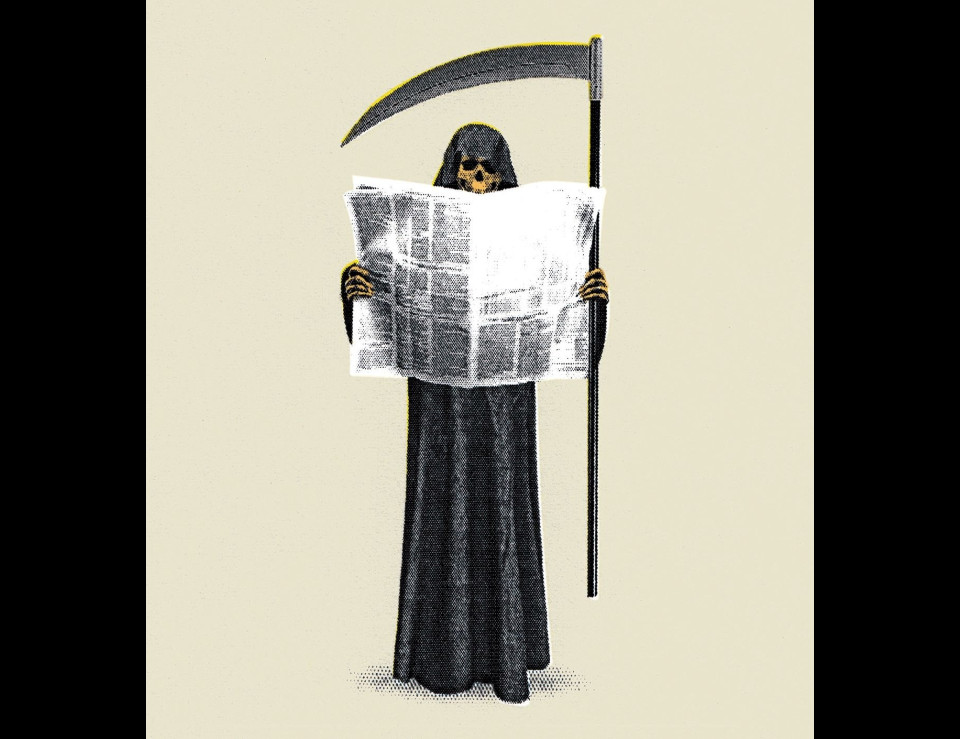
Does Journalism Have a Future?
In an era of social media and fake news, journalists who have survived the print plunge have new foes to face.
By Jill Lepore
The wood-panelled tailgate of the 1972 Oldsmobile station wagon dangled open like a broken jaw, making a wobbly bench on which four kids could sit, eight legs swinging. Every Sunday morning, long before dawn, we’d get yanked out of bed to stuff the car’s way-back with stacks of twine-tied newspapers, clamber onto the tailgate, cut the twine with my mother’s sewing scissors, and ride around town, bouncing along on that bench, while my father shouted out orders from the driver’s seat. “Watch out for the dog!” he’d holler between draws on his pipe. “Inside the screen door!” “Mailbox!” As the car crept along, never stopping, we’d each grab a paper and dash in the dark across icy driveways or dew-drunk grass, crashing, seasonally, into unexpected snowmen. “Back porch!” “Money under the mat!” He kept a list, scrawled on the back of an envelope, taped to the dashboard: the Accounts. “They owe three weeks!” He didn’t need to remind us. We knew each Doberman and every debt. We’d deliver our papers—Worcester Sunday Telegrams—and then run back to the car and scramble onto the tailgate, dropping the coins we’d collected into empty Briggs tobacco tins as we bumped along to the next turn, the newspaper route our Sabbath.
The Worcester Sunday Telegram was founded in 1884, when a telegram meant something fast. Two years later, it became a daily. It was never a great paper but it was always a pretty good paper: useful, gossipy, and resolute. It cultivated talent. The poet Stanley Kunitz was a staff writer for the Telegram in the nineteen-twenties. The New York Times reporter Douglas Kneeland, who covered Kent State and Charles Manson, began his career there in the nineteen-fifties. Joe McGinniss reported for the Telegram in the nineteen-sixties before writing “The Selling of the President.” From bushy-bearded nineteenth-century politicians to baby-faced George W. Bush, the paper was steadfastly Republican, if mainly concerned with scandals and mustachioed villains close to home: overdue repairs to the main branch of the public library, police raids on illegal betting establishments—“worcester dog chases worcester cat over worcester fence,” as the old Washington press-corps joke about a typical headline in a local paper goes. Its pages rolled off giant, thrumming presses in a four-story building that overlooked City Hall the way every city paper used to look out over every city hall, the Bat-Signal over Gotham.
Most newspapers like that haven’t lasted. Between 1970 and 2016, the year the American Society of News Editors quit counting, five hundred or so dailies went out of business; the rest cut news coverage, or shrank the paper’s size, or stopped producing a print edition, or did all of that, and it still wasn’t enough. The newspaper mortality rate is old news, and nostalgia for dead papers is itself pitiful at this point, even though, I still say, there’s a principle involved. “I wouldn’t weep about a shoe factory or a branch-line railroad shutting down,” Heywood Broun, the founder of the American Newspaper Guild, said when the New York World went out of business, in 1931. “But newspapers are different.” And the bleeding hasn’t stopped. Between January, 2017, and April, 2018, a third of the nation’s largest newspapers, including the Denver Post and the San Jose Mercury News, reported layoffs. In a newer trend, so did about a quarter of digital-native news sites. BuzzFeed News laid off a hundred people in 2017; speculation is that BuzzFeed is trying to dump it. The Huffington Post paid most of its writers nothing for years, upping that recently to just above nothing, and yet, despite taking in tens of millions of dollars in advertising revenue in 2018, it failed to turn a profit.
Story first appeared in The New Yorker in the Jan 2019 issue
STORY BY

Mumbai Press Club
Editor
Article posted on 23/01/2019
- Share This Story On:




